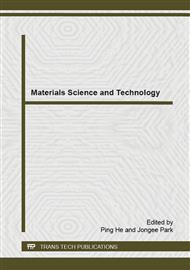[1]
Y. Feng, et al, Microwave absorption properties of the carbonyl iron/EPDM radar absorbing materials, Journal of Wuhan University of Technology-Master. Sci. Ed., Vol. 2 (2007) p.266.
DOI: 10.1007/s11595-005-2266-9
Google Scholar
[2]
R. B. Schulz, et al, Shielding theory and practice, IEEE Transactions on Electromagnetic compatibility, Vol. 30, No. 3 (1988) p.187.
Google Scholar
[3]
B. Zhang, et al, Microwave absorption properties of de-aggregated flake-shaped Carbonyl-Iron particle composites at 2-18 GHz, IEEE Transactions on Magnetics, Vol. 42, No. 7 (2006) p.1178.
DOI: 10.1109/tmag.2006.874188
Google Scholar
[4]
P. Singh, et al, Dielectric constant, magnetic permeability and microwave absorption studies of hot-pressed Ba-CoTi hexaferrite composites in X-band, Journal of Materials Science, Vol. 41, No. 21, (2006) p.7190.
DOI: 10.1007/s10853-006-0921-y
Google Scholar
[5]
P. V. Y. Jayasree, et al, Shielding effectiveness of conductive polymers against EM fields-a case study, IE(I) Journal -ET, Vol. 90 (2009).
Google Scholar
[6]
T. J. F. Konefal, Dawson, A. C. Marvin, Improved aperture model for shielding prediction, IEEE International Symposium on Electromagnetic Compatibility (2003).
DOI: 10.1109/isemc.2003.1236589
Google Scholar
[7]
W. Jarva, Shielding tests for cables and small enclosures in the 1-to 10-GHz range, IEEE Transactions on Electromagnetic Compatibility, Vol. EMC-12 (1970).
DOI: 10.1109/temc.1970.303067
Google Scholar
[8]
K. Naishadham, P. K. Kadaba, Measurement of the microwave conductivity of a polymeric material with potential applications in absorbers and shielding, IEEE Transactions on Microwave theory Technol, Vol. 39, (1991) p.1158.
DOI: 10.1109/22.85383
Google Scholar
[9]
K. S. Ehinger. Summerfield, W. Bauhofer, S. Roth, DC and microwave conductivity of iodine-doped polyacétylène, Journal of Physics C: Solide State physics, Vol. 17, No. 21(1984) p.3753.
DOI: 10.1088/0022-3719/17/21/009
Google Scholar


